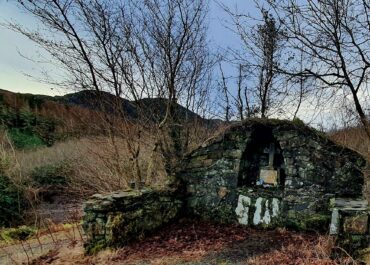Graveyard, Straid (Straid Ed), Co. Donegal
In the townland of Straid in County Donegal lies what's believed to be the early ecclesiastical site of Culmaine, a place where layers of history have accumulated over centuries.
Graveyard, Straid (Straid Ed), Co. Donegal
The site centres around a graveyard that surrounds the ruins of an 18th-century church, built on what was likely sacred ground for far longer. About 14 metres from the church’s southeast corner sits an intriguing relic: a flat stone measuring 30cm by 52cm, marked with two small cup-like depressions. Local tradition holds that these are the knee-prints of St. Colmcille (also known as St. Columba), presumably left behind when the saint knelt here in prayer centuries ago.
The site occupies a strip of fertile land amongst otherwise rough pasture that slopes northeast towards the Clonmany river, a location that would have been deliberately chosen for both its spiritual and practical advantages. Historical records from 1600 mention a castle, though probably more accurately described as a fortified stone house, that once stood beside the church. This building was inhabited by a priest named Amerson, suggesting the site’s continued religious significance even during turbulent times. Though no trace of this structure remains visible today and its exact location has been lost, its documented existence adds another layer to the site’s complex history.
More recently, archaeological investigations have continued to reveal the depth of human activity at this location. A souterrain, one of those mysterious underground passages typical of early medieval Ireland, was discovered in the front garden of a modern bungalow immediately west of the Church of Ireland church. These findings, documented in the Archaeological Survey of County Donegal, paint a picture of a place that has served as a focal point for the local community for well over a millennium, from early Christian times through to the present day.


